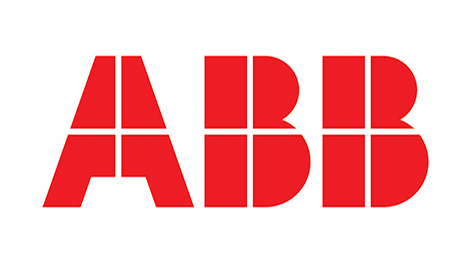ABB – ABB opens refitted, state-of-the-art US robotics facility, reaffirming commitment to US customers
- Refit will support customers and ABB’s leadership in growing US robotics segments, including Packaging & Logistics, Food & Beverage, Construction, Lifesciences & Healthcare and Automotive electric vehicle production
- New factory serves as US hub, developing and manufacturing AI-enabled technology to help businesses respond to labor shortages, global uncertainty and the need to operate more sustainably
- Expansion is latest in over $30 million Robotics investment in the US since 2019 including Packaging & Logistics headquarters in Atlanta, Lifesciences and Healthcare Research Lab in Houston and Research and Development Center in San Jose.
ABB today opened its refitted US robotics headquarters and manufacturing facility in Auburn Hills, Michigan, which will support ABB Robotics’ global leadership in developing and manufacturing cutting-edge robotic solutions in the US, for the US and the Americas. The expanded facility reflects ABB’s commitment to long-term growth in the US market, which is predicted to follow global growth rates for robotics of 8% CAGR*, as well as the company’s global investment to build Robotics and Automation capacity and create new, highly skilled jobs. This is ABB’s third global robotics factory expansion in three years across China, Europe and the Americas and is part of its efforts to further strengthen its local-for-local footprint.
“The opening of our refitted state-of-the-art US robotics headquarters in Auburn Hills, Michigan is a significant part of our global growth story, reaffirming our commitment to industry leadership in the US,” said Sami Atiya, President of ABB’s Robotics and Discrete Automation Business Area. “Robotics and AI are essential tools for companies in addressing critical labor shortages, localized supply chains and the need to operate more sustainably. The advances in AI-driven software and hardware make our robots more accessible to a wider range of businesses, enabling them to increase resilience and become more competitive. America is now the world’s second largest robotics market, and our production facility will help ABB support existing customers as well as new growth sectors across the US and the Americas region.”
“ABB’s $20 million investment in Auburn Hills will create more than 70 good-paying, high-skill jobs and build on Michigan’s advanced manufacturing leadership,” said Governor Whitmer. “Around the world, ABB’s technology supports the production of electric vehicles, medical devices, electronics, and even pastries. Today’s expansion at their robotics headquarters will tighten the supply chain and cut down on production delays, while building on ABB’s long-standing investments in local workforce development and hands-on education. Let’s keep competing to bring more cutting-edge investments home to Michigan.”
With a 30 percent increase in facility space, the new Auburn Hills facility will enhance ABB’s ability to serve as the leading strategic robotics partner for its growing customer base. Through the new Customer Experience Center, ABB will showcase its leading hardware and software solutions, pioneering the latest digital and AI-powered automation technologies with customers, and developing and manufacturing next generation robots.
The expanded facility will support ABB Robotics’ specialist centers including its Packaging and Logistics hub in Atlanta, Georgia; its Life Sciences and Healthcare hub at the Texas Medical Center in Houston, Texas; and AI Research Lab in San Jose, California. Complete with a new training center, the facility will educate over 3,000 workers and students each year, equipping them with the skills to thrive in a new era of AI-powered automation.
“Through our expanded facility, partner ecosystem and comprehensive AI-enabled product portfolio, we are pushing the boundaries of technology to drive performance to new levels,” said John Bubnikovich, ABB United States Robotics Division President. “We look forward to increasing support for our customers, to expanding our role as an employer and to energizing the transformation of society and industry to achieve a more productive, sustainable future.”
The expansion reflects the company’s focus on the US market and commitment to continued investment in Michigan. The expansion will create 72 highly skilled new jobs in the area and is supported by a $450,000 Michigan Business Development Program performance-based grant. In addition to capitalizing on the unique concentration of technical skills in the community, ABB will provide upskilling and career opportunities to train workers with no prior experience or degree with the skills needed to build a successful career in the robotics and automation industry. ABB Robotics has invested $30 million in the U. since 2019 across four locations, opening its Auburn Hills manufacturing facility in 2015. The recent investment in Auburn Hills is part of the previously announced approximately $170 million that ABB is investing in its electrification and automation businesses across the US.
* ABB Mgt Estimate 2023 – 2026
SourceABB
EMR Analysis
More information on ABB: See full profile on EMR Executive Services
More information on Björn Rosengren (Chief Executive Officer and Member of the Group Executive Committee, ABB until July 31, 2024 + Advisor to the Chief Executive Officer and to the Executive Committee, ABB until December 31, 2024): See the full profile on EMR Executive Services
More information on Morten Wierod (President, Electrification and Member of the Executive Committee, ABB + Member of the Board of Directors, ABB E-mobility Holding AG + Chief Executive Officer and Member of the Group Executive Committee, ABB as from August 1, 2024): See full profile on EMR Executive Services
More information on ABB Robotics & Discrete Automation: https://new.abb.com/products/robotics + ABB Robotics & Discrete Automation is the only company with a comprehensive and integrated portfolio covering robots, Autonomous Mobile Robots and machine automation solutions, designed and orchestrated by our value-creating software. We help companies of all sizes and sectors – from automotive to electronics and logistics – become more resilient, flexible and efficient. ABB Robotics & Discrete Automation supports customers in the transition towards the connected and collaborative factory of the future. The business area employs approximately 11,000 people at over 250 locations in more than 50 countries.
More information on Sami Atiya (President, Robotics & Discrete Automation and Member of the Executive Committee, ABB): See full profile on EMR Executive Services
More information on Marc Segura (President, ABB Robotics, ABB): See full profile on EMR Executive Services
More information on John Bubnikovich (President, ABB United States Robotics Division, ABB): See full profile on EMR Executive Services
More information on Gretchen Whitmer (Governor, Michigan, United States): https://www.michigan.gov/whitmer + https://www.linkedin.com/in/gretchenwhitmer
EMR Additional Notes:
- AI – Artificial Intelligence:
- https://searchenterpriseai.techtarget.com/definition/AI-Artificial-Intelligence +
- Artificial intelligence is the simulation of human intelligence processes by machines, especially computer systems.
- As the hype around AI has accelerated, vendors have been scrambling to promote how their products and services use AI. Often what they refer to as AI is simply one component of AI, such as machine learning. AI requires a foundation of specialized hardware and software for writing and training machine learning algorithms. No one programming language is synonymous with AI, but well a few, including Python, R and Java, are popular.
- In general, AI systems work by ingesting large amounts of labeled training data, analyzing the data for correlations and patterns, and using these patterns to make predictions about future states. In this way, a chatbot that is fed examples of text chats can learn to produce lifelike exchanges with people, or an image recognition tool can learn to identify and describe objects in images by reviewing millions of examples.
- AI programming focuses on three cognitive skills: learning, reasoning and self-correction.
- What are the 4 types of artificial intelligence?
- Type 1: Reactive machines. These AI systems have no memory and are task specific. An example is Deep Blue, the IBM chess program that beat Garry Kasparov in the 1990s. Deep Blue can identify pieces on the chessboard and make predictions, but because it has no memory, it cannot use past experiences to inform future ones.
- Type 2: Limited memory. These AI systems have memory, so they can use past experiences to inform future decisions. Some of the decision-making functions in self-driving cars are designed this way.
- Type 3: Theory of mind. Theory of mind is a psychology term. When applied to AI, it means that the system would have the social intelligence to understand emotions. This type of AI will be able to infer human intentions and predict behavior, a necessary skill for AI systems to become integral members of human teams.
- Type 4: Self-awareness. In this category, AI systems have a sense of self, which gives them consciousness. Machines with self-awareness understand their own current state. This type of AI does not yet exist.
- Machine Learning (ML):
- Developed to mimic human intelligence, it lets the machines learn independently by ingesting vast amounts of data, statistics formulas and detecting patterns.
- ML allows software applications to become more accurate at predicting outcomes without being explicitly programmed to do so.
- ML algorithms use historical data as input to predict new output values.
- Recommendation engines are a common use case for ML. Other uses include fraud detection, spam filtering, business process automation (BPA) and predictive maintenance.
- Classical ML is often categorized by how an algorithm learns to become more accurate in its predictions. There are four basic approaches: supervised learning, unsupervised learning, semi-supervised learning and reinforcement learning.
- Deep Learning (DL):
- Subset of machine learning, Deep Learning enabled much smarter results than were originally possible with ML. Face recognition is a good example.
- DL makes use of layers of information processing, each gradually learning more and more complex representations of data. The early layers may learn about colors, the next ones about shapes, the following about combinations of those shapes, and finally actual objects. DL demonstrated a breakthrough in object recognition.
- DL is currently the most sophisticated AI architecture we have developed.
- Computer Vision (CV):
- Computer vision is a field of artificial intelligence that enables computers and systems to derive meaningful information from digital images, videos and other visual inputs — and take actions or make recommendations based on that information.
- The most well-known case of this today is Google’s Translate, which can take an image of anything — from menus to signboards — and convert it into text that the program then translates into the user’s native language.
- Machine Vision (MV):
- Machine Vision is the ability of a computer to see; it employs one or more video cameras, analog-to-digital conversion and digital signal processing. The resulting data goes to a computer or robot controller. Machine Vision is similar in complexity to Voice Recognition.
- MV uses the latest AI technologies to give industrial equipment the ability to see and analyze tasks in smart manufacturing, quality control, and worker safety.
- Computer Vision systems can gain valuable information from images, videos, and other visuals, whereas Machine Vision systems rely on the image captured by the system’s camera. Another difference is that Computer Vision systems are commonly used to extract and use as much data as possible about an object.
- Generative AI (GenAI):
- Generative AI technology generates outputs based on some kind of input – often a prompt supplied by a person. Some GenAI tools work in one medium, such as turning text inputs into text outputs, for example. With the public release of ChatGPT in late November 2022, the world at large was introduced to an AI app capable of creating text that sounded more authentic and less artificial than any previous generation of computer-crafted text.
- https://searchenterpriseai.techtarget.com/definition/AI-Artificial-Intelligence +
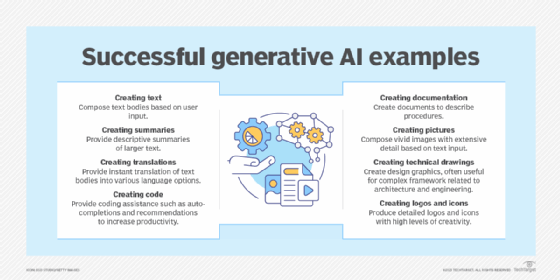
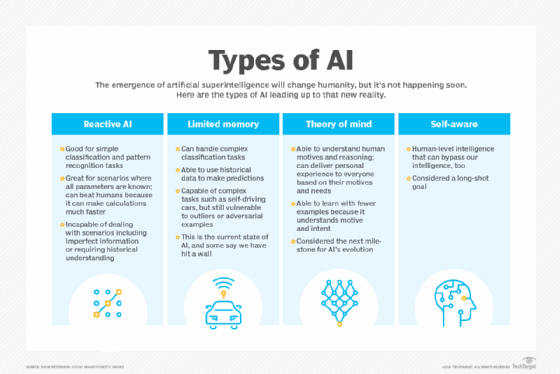
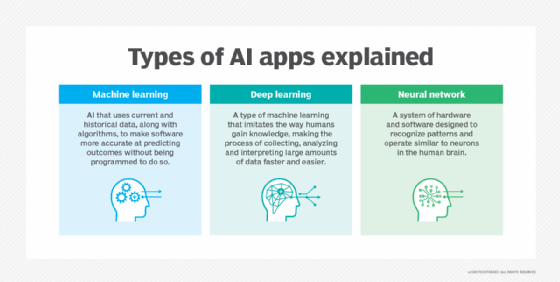
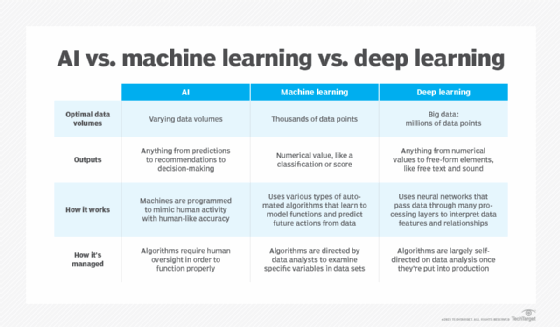
- Edge AI Technology:
- Edge artificial intelligence refers to the deployment of AI algorithms and AI models directly on local edge devices such as sensors or Internet of Things (IoT) devices, which enables real-time data processing and analysis without constant reliance on cloud infrastructure.
- Simply stated, edge AI, or “AI on the edge“, refers to the combination of edge computing and artificial intelligence to execute machine learning tasks directly on interconnected edge devices. Edge computing allows for data to be stored close to the device location, and AI algorithms enable the data to be processed right on the network edge, with or without an internet connection. This facilitates the processing of data within milliseconds, providing real-time feedback.
- Self-driving cars, wearable devices, security cameras, and smart home appliances are among the technologies that leverage edge AI capabilities to promptly deliver users with real-time information when it is most essential.
- Software vs. Hardware vs. Firmware:
- Hardware is physical: It’s “real,” sometimes breaks, and eventually wears out.
- Since hardware is part of the “real” world, it all eventually wears out. Being a physical thing, it’s also possible to break it, drown it, overheat it, and otherwise expose it to the elements.
- Here are some examples of hardware:
- Smartphone
- Tablet
- Laptop
- Desktop computer
- Printer
- Flash drive
- Router
- Software is virtual: It can be copied, changed, and destroyed.
- Software is everything about your computer that isn’t hardware.
- Here are some examples of software:
- Operating systems like Windows 11 or iOS
- Web browsers
- Antivirus tools
- Adobe Photoshop
- Mobile apps
- Firmware is virtual: It’s software specifically designed for a piece of hardware
- While not as common a term as hardware or software, firmware is everywhere—on your smartphone, your PC’s motherboard, your camera, your headphones, and even your TV remote control.
- Firmware is just a special kind of software that serves a very narrow purpose for a piece of hardware. While you might install and uninstall software on your computer or smartphone on a regular basis, you might only rarely, if ever, update the firmware on a device, and you’d probably only do so if asked by the manufacturer, probably to fix a problem.
- Hardware is physical: It’s “real,” sometimes breaks, and eventually wears out.

